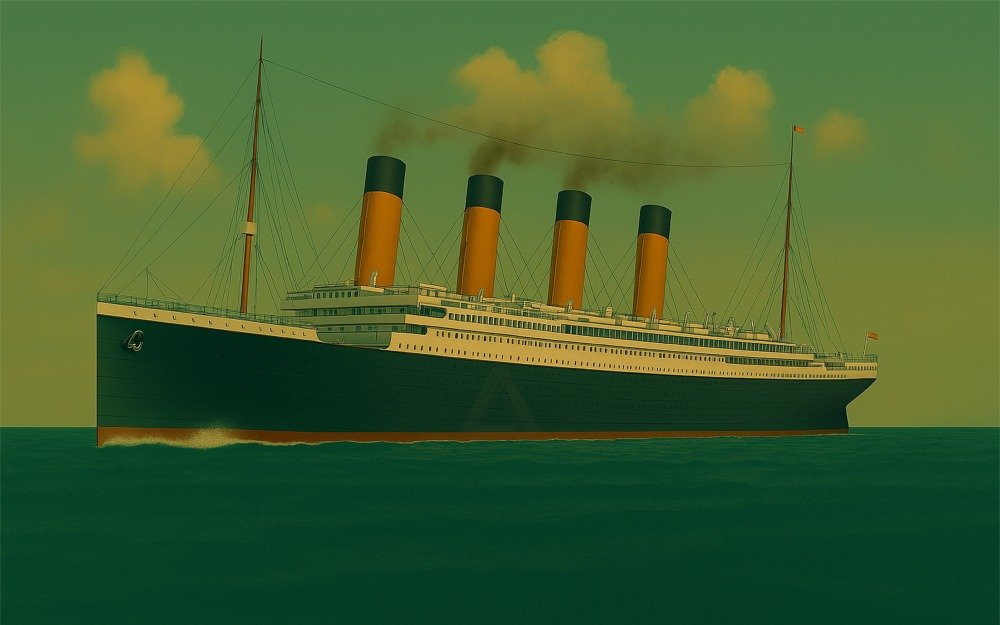
In 1898, American author Morgan Robertson published a novella called Futility, later retitled The Wreck of the Titan. It told the story of a massive British passenger liner — Titan — billed as unsinkable, which struck an iceberg and sank in April. Fourteen years later, Titanic met a fate that felt eerily familiar. The similarities — size, lifeboat shortages, timing, location— have drawn comparisons ever since. Robertson dismissed claims of prophecy. “I know what I’m writing about, that’s all,” he said.
A Fictional Ship Called Titan
Morgan Robertson’s Futility introduced readers to Titan, a fictional British passenger liner described as the largest ship afloat. Measuring 800 feet long and weighing 45,000 tons, Titan was equipped with a triple-screw propulsion system and boasted nineteen watertight compartments — features that mirrored the design elements of the real-life Titanic. Like its real-world counterpart, Titan was billed as unsinkable and designed to withstand a head-on collision with an iceberg. But in Robertson’s narrative, that confidence proved fatal.
Titan’s voyage in Futility begins with assurance. The ship, described as indestructible, was outfitted with just enough lifeboats to meet legal requirements — twenty-four in total, lashed down and covered. Robertson’s narrative doesn’t linger on hubris, but it’s there in the margins: Titan is fast, formidable, and built to survive a head-on collision with an iceberg. That assumption proves fatal. On a cold April night, Titan strikes ice and founders. Most passengers perish.
Titanic Sets Sail
Fourteen years after Futility was published, RMS Titanic departed Southampton on her maiden voyage. She was the largest ship afloat, measuring 882 feet long and weighing over 46,000 tons. Like Titan, she carried just enough lifeboats to meet outdated maritime regulations — twenty in total, far short of what was needed. On the night of April 14, 1912, Titanic struck an iceberg in the North Atlantic. By morning, she was gone, and more than fifteen hundred lives were lost.
Titanic struck the berg just before midnight. The starboard hull was severely damaged below the waterline, and water surged through the watertight compartments — faster than the ship could contain. Radio operators sent urgent wireless messages, but the nearest ships were out of reach. By dawn, only debris remained. Survivors spoke of silence, scattered cries, and moments that defied explanation. The loss was vast and painful to measure.
Futility Reemerges After 1912
After Titanic sank, Futility reappeared in newspaper columns and bookshops. The parallels were hard to ignore: a fictional ship named Titan, an iceberg, a fatal April night. Some claimed Robertson had predicted the disaster. He disagreed. “I know what I’m writing about, that’s all,” he said. The story, once overlooked, was suddenly everywhere.
The Mythology of Titan and Titanic
Over time, the parallels between Titan and Titanic moved beyond coincidence. The story of Futility became part of Titanic’s mythology — cited in documentaries, conspiracy theories, and classroom trivia. Some saw it as proof of premonition; others dismissed it as coincidence dressed in hindsight. But the novella’s endurance speaks to something deeper: our need to find patterns in tragedy, and meaning in disaster.
Why Futility Endures
After 1912, Futility was no longer just a maritime novella. It became a reference point — cited in passing, debated in print, and occasionally dismissed as coincidence. The book didn’t predict Titanic, but it lingered in the margins of the story, unsettling in its detail and timing. Robertson claimed he simply understood ships. Maybe that’s true. But the overlap between Titan and Titanic still unsettles readers, not because it was predicted, but because it was possible.
Eerie Coincidences
Note: Robertson revised Titan’s specs in 1912 to more closely match Titanic’s dimensions.
Note: Both ships were among the largest of their time.
Note: Three propellers—unusual for the era—enabled high speed and maneuverability.
Note: Flooding exceeded the survivable threshold in both cases.
Note: Both ships were engineered to survive limited flooding — but not the extent they faced.
Note: Both ships were near full capacity; Titan’s fictional loss was nearly total.
Note: Both met outdated legal minimums—far below actual need.
Note: Spring crossings in the North Atlantic carried known iceberg risks.
Note: Wreck sites were less than 100 km apart.
Note: Both ships were travelling near full speed despite iceberg warnings.
Note: Titanic was officially registered in Liverpool and bore the city’s name on her stern. Southampton, however, was the primary departure point for transatlantic luxury liners — including Titanic’s maiden voyage.
Misconceptions and the Need for Restraint
The story of Futility and Titanic has attracted embellishment for over a century. Some claim both ships sank on their maiden voyages. Only Titanic did. Others say Titan’s lookouts lacked binoculars — mirroring Titanic’s infamous oversight. But Robertson’s text makes no mention of binoculars, and the parallel remains speculative.
J. Bruce Ismay held dual roles at White Star Line — Managing Director and Chairman. He survived the sinking and became a target. Some claimed he urged Captain Smith to maintain speed. Others said he escaped disguised as a woman. Neither claim appears in inquiry records, but both stuck.
Ismay was seen near lifeboats and may have assisted with loading. He boarded Collapsible C late in the evacuation, reportedly after no further women came forward. Whether he waited or simply seized a chance remains unclear. The claim that he sought a crossing record is often repeated, but no testimony substantiates it.
After the disaster, Ismay resigned and withdrew from public life. He lived in seclusion for decades. The press — especially Hearst’s syndicate — ensured the accusations stuck, regardless of what the record showed.
Titanic’s lookouts lacked binoculars. The key to the locker was mistakenly taken ashore by a reassigned officer. Whether binoculars would have made a difference remains debated. The night was moonless, the sea glassy, and the iceberg gave no warning.
Other myths persist: that Titanic was racing for a record, that third-class passengers were locked below, that the ship broke in half above water. Each claim carries fragments of truth, but none hold fully under scrutiny.
The moral, if there is one, is editorial. The similarities between Titan and Titanic are astonishing enough to stand without embellishment.
Giants Lost at Sea
Titanic’s sinking wasn’t just a maritime disaster — it was a cultural reckoning. Among the 1,500 lives lost were figures who shaped finance, industry, politics, and design. Their deaths echoed far beyond the North Atlantic.
John Jacob Astor IV, one of the wealthiest men in the world, went down with the ship. He had just returned from honeymooning with his young wife, who survived. Astor’s death marked the end of an era — his fortune built on real estate, invention, and war-time service.
Benjamin Guggenheim, heir to a mining empire, reportedly changed into evening wear as the ship sank, declaring he was “prepared to go down like a gentleman.” His valet and steward stayed with him. None survived.
Isidor Straus, co-owner of Macy’s, refused a lifeboat seat. His wife Ida chose to stay with him. Witnesses saw them seated together on deck as the ship went down. Their story became emblematic of loyalty and loss.
Captain Edward J. Smith, Titanic’s commanding officer, was revered as a “millionaire’s captain”—trusted by elite passengers and respected by crew. His final moments remain disputed. Some say he went down on the bridge. Others recall him swimming toward lifeboats, urging survivors to row clear.
Thomas Andrews, chief designer from Harland and Wolff, was aboard to observe Titanic’s performance. Survivors described him moving through the ship, urging passengers to don lifejackets and head for the deck. He was last seen in the first-class smoking room, calm and alone.
Others lost include Major Archibald Butt, military aide to Presidents Roosevelt and Taft; William T. Stead, pioneering journalist and peace advocate; and Henry Birkhardt Harris, a Broadway producer whose wife survived.
These weren’t just names — they were symbols of modernity, wealth, and progress. Their deaths punctured the myth of invincibility. The ship was unsinkable. They were untouchable. Neither claim held.
🔗 Think that was strange? There’s more. Explore our full Uncanny Coincidences archive
References:
[1] Wikipedia. “The Wreck of the Titan: Or, Futility.” Retrieved September 9, 2025, from Wikipedia — The Wreck of the Titan
[2] Royal Museums Greenwich. “Futility: how a novel foreshadowed the sinking of the Titanic.” Retrieved September 9, 2025, from Royal Museums Greenwich — Futility and Titanic
[3] Titanic Wiki. “Futility, or the Wreck of the Titan.” Retrieved September 9, 2025, from Titanic Wiki — Futility
[4] Wikisource. “Futility, or the Wreck of the Titan by Morgan Robertson.” Retrieved September 9, 2025, from Wikisource — Full Text of Futility
[5] Encyclopedia Titanica. “J. Bruce Ismay.” Retrieved September 9, 2025, from Encyclopedia Titanica — J. Bruce Ismay
[6] History.com. “Titanic.” Retrieved September 9, 2025, from History.com — Titanic Overview
[7] Smithsonian Magazine. “Titanic’s Final Hours.” Retrieved September 9, 2025, from Smithsonian Magazine — Titanic’s Final Hours
